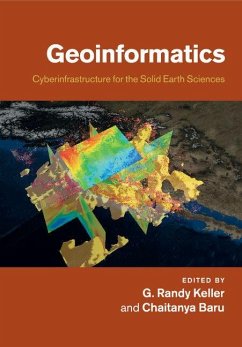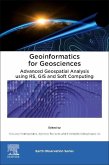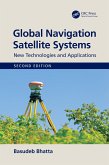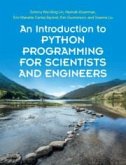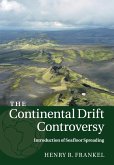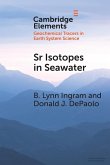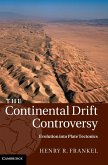Geoinformatics
Herausgeber: Keller, G. Randy; Baru, Chaitanya
Geoinformatics
Herausgeber: Keller, G. Randy; Baru, Chaitanya
- Broschiertes Buch
- Merkliste
- Auf die Merkliste
- Bewerten Bewerten
- Teilen
- Produkt teilen
- Produkterinnerung
- Produkterinnerung
Advanced information technology infrastructure is being increasingly employed in the Earth sciences. Geoinformatics uses a series of case studies to provide a fascinating and accessible introduction to this emerging field and an invaluable reference for researchers interested in developing new cyberinfrastructure projects of their own.
Andere Kunden interessierten sich auch für
![Geoinformatics for Geosciences Geoinformatics for Geosciences]() Geoinformatics for Geosciences164,99 €
Geoinformatics for Geosciences164,99 €![Global Navigation Satellite Systems Global Navigation Satellite Systems]() Basudeb Bhatta (Computer Aided Design Centre, Jadavpur University,Global Navigation Satellite Systems64,99 €
Basudeb Bhatta (Computer Aided Design Centre, Jadavpur University,Global Navigation Satellite Systems64,99 €![An Introduction to Python Programming for Scientists and Engineers An Introduction to Python Programming for Scientists and Engineers]() Johnny Wei-Bing LinAn Introduction to Python Programming for Scientists and Engineers54,99 €
Johnny Wei-Bing LinAn Introduction to Python Programming for Scientists and Engineers54,99 €![Ecotoxicology Ecotoxicology]() Peter G. C. CampbellEcotoxicology49,99 €
Peter G. C. CampbellEcotoxicology49,99 €![The Continental Drift Controversy The Continental Drift Controversy]() Henry R. Frankel (Kansas City University of Missouri)The Continental Drift Controversy70,99 €
Henry R. Frankel (Kansas City University of Missouri)The Continental Drift Controversy70,99 €![Sr Isotopes in Seawater Sr Isotopes in Seawater]() B. Lynn Ingram (Berkeley University of California)Sr Isotopes in Seawater22,99 €
B. Lynn Ingram (Berkeley University of California)Sr Isotopes in Seawater22,99 €![The Continental Drift Controversy The Continental Drift Controversy]() Henry R. Frankel (Kansas City University of Missouri)The Continental Drift Controversy191,99 €
Henry R. Frankel (Kansas City University of Missouri)The Continental Drift Controversy191,99 €-
-
-
Advanced information technology infrastructure is being increasingly employed in the Earth sciences. Geoinformatics uses a series of case studies to provide a fascinating and accessible introduction to this emerging field and an invaluable reference for researchers interested in developing new cyberinfrastructure projects of their own.
Produktdetails
- Produktdetails
- Verlag: Cambridge University Press
- Seitenzahl: 414
- Erscheinungstermin: 22. September 2017
- Englisch
- Abmessung: 244mm x 170mm x 22mm
- Gewicht: 244g
- ISBN-13: 9781108446587
- ISBN-10: 1108446582
- Artikelnr.: 49449032
- Herstellerkennzeichnung
- Libri GmbH
- Europaallee 1
- 36244 Bad Hersfeld
- gpsr@libri.de
- Verlag: Cambridge University Press
- Seitenzahl: 414
- Erscheinungstermin: 22. September 2017
- Englisch
- Abmessung: 244mm x 170mm x 22mm
- Gewicht: 244g
- ISBN-13: 9781108446587
- ISBN-10: 1108446582
- Artikelnr.: 49449032
- Herstellerkennzeichnung
- Libri GmbH
- Europaallee 1
- 36244 Bad Hersfeld
- gpsr@libri.de
List of contributors; Preface; Introduction: 1. Science needs and
challenges for geoinformatics G. Randy Keller; 2. Introduction to IT
concepts and challenges Chaitanya Baru; Part I. Case Studies from Other
Disciplines: 3. Semantic cyberinfrastructure: the virtual solar-terrestrial
observatory Peter Fox and Deborah L. McGuinness; 4. Cyberinfrastructures
for life sciences and biomedicine Sriram Krishnan and Ravi Madduri; Part
II. Modeling Software and Community Codes: 5. Development, verification and
maintenance of computational software in geodynamics Michael Gurnis, Walter
Landry, Eh Tan, Luis Armendariz, Leif Strand and Michael Aivazis; 6.
Parallel finite element modeling of multi-timescale faulting and
lithospheric deformation in the western US Mian Liu, Youqing Yang, Qingsong
Li, Gang Luo and Huai Zhang; 7. Next-generation plate-tectonic
reconstructions using GPlates James A. Boyden, R. Dietmar Müller, Michael
Gurnis, Trond H. Torsvik, James A. Clark, Mark Turner, Hamish Ivey-Law,
Robin J. Watson and John S. Cannon; Part III. Visualization and Data
Representation: 8. Visualization of seismic model data Amit Chourasia; 9.
The UNAVCO GEON Integrated Data Viewer for exploration, analysis, and
integration of geoscience data Stuart Wier and Charles Meertens; Part IV.
Knowledge Management and Data Integration: 10. Data and tools for geologic
timelines and timescales Peter Sadler and Cinzia Cervato; 11. Modeling
geodynamic processes with ontologies Hassan Babaie; Part V. Web Services
and Scientific Workflows: 12. Service orientation in the design of a
community hydrologic information system Ilya Zaslavsky and David Maidment;
13. Web services for seismic data archives Robert Casey and Timothy Ahern;
14. Development of robust data system for gravity and magnetic anomaly
data: a case study of a community-based effort for point data Raed Aldouri
and G. Randy Keller; 15. Scientific workflows for the geosciences: an
emerging approach to building integrated data analysis systems Ilkay
Altintas, Daniel Crawl and Christopher Crosby; 16. Online access and
processing of Lidar topography data Christopher Crosby, J. Ramon
Arrowsmith, Viswanath Nandigam and Chaitanya Baru; 17. Use of abstraction
to support geoscientists' understanding and production of scientific
artifacts Ann Gates, Paulo Pinheiro da Silva, Leonardo Salayandia, Omar
Ochoa, Aida Gandara and Nicholas Del Rio; Part VI. Emerging International
and Other Efforts: 18. It's not your data, it's everyone's: the benefits of
a corporate approach to scientific information Ian Jackson and Richard
Hughes; 19. TOPO-EUROPE and cyberinfrastructure: quantifying coupled deep
earth-surface processes in 4D Sierd Cloetingh and H. P. Bunge; 20.
OneGeology - from concept to global project Ian Jackson; 21. Geoinformatics
developments in Germany Jens Klump, Joachim Wächter, Peter Löwe, Ralf Bill
and Matthias Lendholt; 22. iGEON: networking the Indian geosciences
community through GEON K. V. Subbarao, Arun Agarwal, Rajeev Wankar and
Chaitanya Baru; 23. Geoinformatics in the public service: building a
cyberinfrastructure across the geological surveys M. Lee Allison, Linda C.
Gundersen and Stephen M. Richard; 24. Application of the U.S. geoscience
information network to deploying a national geothermal data system Stephen
M. Richard, Ryan Clark and Wolfgang Grunberg; Index.
challenges for geoinformatics G. Randy Keller; 2. Introduction to IT
concepts and challenges Chaitanya Baru; Part I. Case Studies from Other
Disciplines: 3. Semantic cyberinfrastructure: the virtual solar-terrestrial
observatory Peter Fox and Deborah L. McGuinness; 4. Cyberinfrastructures
for life sciences and biomedicine Sriram Krishnan and Ravi Madduri; Part
II. Modeling Software and Community Codes: 5. Development, verification and
maintenance of computational software in geodynamics Michael Gurnis, Walter
Landry, Eh Tan, Luis Armendariz, Leif Strand and Michael Aivazis; 6.
Parallel finite element modeling of multi-timescale faulting and
lithospheric deformation in the western US Mian Liu, Youqing Yang, Qingsong
Li, Gang Luo and Huai Zhang; 7. Next-generation plate-tectonic
reconstructions using GPlates James A. Boyden, R. Dietmar Müller, Michael
Gurnis, Trond H. Torsvik, James A. Clark, Mark Turner, Hamish Ivey-Law,
Robin J. Watson and John S. Cannon; Part III. Visualization and Data
Representation: 8. Visualization of seismic model data Amit Chourasia; 9.
The UNAVCO GEON Integrated Data Viewer for exploration, analysis, and
integration of geoscience data Stuart Wier and Charles Meertens; Part IV.
Knowledge Management and Data Integration: 10. Data and tools for geologic
timelines and timescales Peter Sadler and Cinzia Cervato; 11. Modeling
geodynamic processes with ontologies Hassan Babaie; Part V. Web Services
and Scientific Workflows: 12. Service orientation in the design of a
community hydrologic information system Ilya Zaslavsky and David Maidment;
13. Web services for seismic data archives Robert Casey and Timothy Ahern;
14. Development of robust data system for gravity and magnetic anomaly
data: a case study of a community-based effort for point data Raed Aldouri
and G. Randy Keller; 15. Scientific workflows for the geosciences: an
emerging approach to building integrated data analysis systems Ilkay
Altintas, Daniel Crawl and Christopher Crosby; 16. Online access and
processing of Lidar topography data Christopher Crosby, J. Ramon
Arrowsmith, Viswanath Nandigam and Chaitanya Baru; 17. Use of abstraction
to support geoscientists' understanding and production of scientific
artifacts Ann Gates, Paulo Pinheiro da Silva, Leonardo Salayandia, Omar
Ochoa, Aida Gandara and Nicholas Del Rio; Part VI. Emerging International
and Other Efforts: 18. It's not your data, it's everyone's: the benefits of
a corporate approach to scientific information Ian Jackson and Richard
Hughes; 19. TOPO-EUROPE and cyberinfrastructure: quantifying coupled deep
earth-surface processes in 4D Sierd Cloetingh and H. P. Bunge; 20.
OneGeology - from concept to global project Ian Jackson; 21. Geoinformatics
developments in Germany Jens Klump, Joachim Wächter, Peter Löwe, Ralf Bill
and Matthias Lendholt; 22. iGEON: networking the Indian geosciences
community through GEON K. V. Subbarao, Arun Agarwal, Rajeev Wankar and
Chaitanya Baru; 23. Geoinformatics in the public service: building a
cyberinfrastructure across the geological surveys M. Lee Allison, Linda C.
Gundersen and Stephen M. Richard; 24. Application of the U.S. geoscience
information network to deploying a national geothermal data system Stephen
M. Richard, Ryan Clark and Wolfgang Grunberg; Index.
List of contributors; Preface; Introduction: 1. Science needs and
challenges for geoinformatics G. Randy Keller; 2. Introduction to IT
concepts and challenges Chaitanya Baru; Part I. Case Studies from Other
Disciplines: 3. Semantic cyberinfrastructure: the virtual solar-terrestrial
observatory Peter Fox and Deborah L. McGuinness; 4. Cyberinfrastructures
for life sciences and biomedicine Sriram Krishnan and Ravi Madduri; Part
II. Modeling Software and Community Codes: 5. Development, verification and
maintenance of computational software in geodynamics Michael Gurnis, Walter
Landry, Eh Tan, Luis Armendariz, Leif Strand and Michael Aivazis; 6.
Parallel finite element modeling of multi-timescale faulting and
lithospheric deformation in the western US Mian Liu, Youqing Yang, Qingsong
Li, Gang Luo and Huai Zhang; 7. Next-generation plate-tectonic
reconstructions using GPlates James A. Boyden, R. Dietmar Müller, Michael
Gurnis, Trond H. Torsvik, James A. Clark, Mark Turner, Hamish Ivey-Law,
Robin J. Watson and John S. Cannon; Part III. Visualization and Data
Representation: 8. Visualization of seismic model data Amit Chourasia; 9.
The UNAVCO GEON Integrated Data Viewer for exploration, analysis, and
integration of geoscience data Stuart Wier and Charles Meertens; Part IV.
Knowledge Management and Data Integration: 10. Data and tools for geologic
timelines and timescales Peter Sadler and Cinzia Cervato; 11. Modeling
geodynamic processes with ontologies Hassan Babaie; Part V. Web Services
and Scientific Workflows: 12. Service orientation in the design of a
community hydrologic information system Ilya Zaslavsky and David Maidment;
13. Web services for seismic data archives Robert Casey and Timothy Ahern;
14. Development of robust data system for gravity and magnetic anomaly
data: a case study of a community-based effort for point data Raed Aldouri
and G. Randy Keller; 15. Scientific workflows for the geosciences: an
emerging approach to building integrated data analysis systems Ilkay
Altintas, Daniel Crawl and Christopher Crosby; 16. Online access and
processing of Lidar topography data Christopher Crosby, J. Ramon
Arrowsmith, Viswanath Nandigam and Chaitanya Baru; 17. Use of abstraction
to support geoscientists' understanding and production of scientific
artifacts Ann Gates, Paulo Pinheiro da Silva, Leonardo Salayandia, Omar
Ochoa, Aida Gandara and Nicholas Del Rio; Part VI. Emerging International
and Other Efforts: 18. It's not your data, it's everyone's: the benefits of
a corporate approach to scientific information Ian Jackson and Richard
Hughes; 19. TOPO-EUROPE and cyberinfrastructure: quantifying coupled deep
earth-surface processes in 4D Sierd Cloetingh and H. P. Bunge; 20.
OneGeology - from concept to global project Ian Jackson; 21. Geoinformatics
developments in Germany Jens Klump, Joachim Wächter, Peter Löwe, Ralf Bill
and Matthias Lendholt; 22. iGEON: networking the Indian geosciences
community through GEON K. V. Subbarao, Arun Agarwal, Rajeev Wankar and
Chaitanya Baru; 23. Geoinformatics in the public service: building a
cyberinfrastructure across the geological surveys M. Lee Allison, Linda C.
Gundersen and Stephen M. Richard; 24. Application of the U.S. geoscience
information network to deploying a national geothermal data system Stephen
M. Richard, Ryan Clark and Wolfgang Grunberg; Index.
challenges for geoinformatics G. Randy Keller; 2. Introduction to IT
concepts and challenges Chaitanya Baru; Part I. Case Studies from Other
Disciplines: 3. Semantic cyberinfrastructure: the virtual solar-terrestrial
observatory Peter Fox and Deborah L. McGuinness; 4. Cyberinfrastructures
for life sciences and biomedicine Sriram Krishnan and Ravi Madduri; Part
II. Modeling Software and Community Codes: 5. Development, verification and
maintenance of computational software in geodynamics Michael Gurnis, Walter
Landry, Eh Tan, Luis Armendariz, Leif Strand and Michael Aivazis; 6.
Parallel finite element modeling of multi-timescale faulting and
lithospheric deformation in the western US Mian Liu, Youqing Yang, Qingsong
Li, Gang Luo and Huai Zhang; 7. Next-generation plate-tectonic
reconstructions using GPlates James A. Boyden, R. Dietmar Müller, Michael
Gurnis, Trond H. Torsvik, James A. Clark, Mark Turner, Hamish Ivey-Law,
Robin J. Watson and John S. Cannon; Part III. Visualization and Data
Representation: 8. Visualization of seismic model data Amit Chourasia; 9.
The UNAVCO GEON Integrated Data Viewer for exploration, analysis, and
integration of geoscience data Stuart Wier and Charles Meertens; Part IV.
Knowledge Management and Data Integration: 10. Data and tools for geologic
timelines and timescales Peter Sadler and Cinzia Cervato; 11. Modeling
geodynamic processes with ontologies Hassan Babaie; Part V. Web Services
and Scientific Workflows: 12. Service orientation in the design of a
community hydrologic information system Ilya Zaslavsky and David Maidment;
13. Web services for seismic data archives Robert Casey and Timothy Ahern;
14. Development of robust data system for gravity and magnetic anomaly
data: a case study of a community-based effort for point data Raed Aldouri
and G. Randy Keller; 15. Scientific workflows for the geosciences: an
emerging approach to building integrated data analysis systems Ilkay
Altintas, Daniel Crawl and Christopher Crosby; 16. Online access and
processing of Lidar topography data Christopher Crosby, J. Ramon
Arrowsmith, Viswanath Nandigam and Chaitanya Baru; 17. Use of abstraction
to support geoscientists' understanding and production of scientific
artifacts Ann Gates, Paulo Pinheiro da Silva, Leonardo Salayandia, Omar
Ochoa, Aida Gandara and Nicholas Del Rio; Part VI. Emerging International
and Other Efforts: 18. It's not your data, it's everyone's: the benefits of
a corporate approach to scientific information Ian Jackson and Richard
Hughes; 19. TOPO-EUROPE and cyberinfrastructure: quantifying coupled deep
earth-surface processes in 4D Sierd Cloetingh and H. P. Bunge; 20.
OneGeology - from concept to global project Ian Jackson; 21. Geoinformatics
developments in Germany Jens Klump, Joachim Wächter, Peter Löwe, Ralf Bill
and Matthias Lendholt; 22. iGEON: networking the Indian geosciences
community through GEON K. V. Subbarao, Arun Agarwal, Rajeev Wankar and
Chaitanya Baru; 23. Geoinformatics in the public service: building a
cyberinfrastructure across the geological surveys M. Lee Allison, Linda C.
Gundersen and Stephen M. Richard; 24. Application of the U.S. geoscience
information network to deploying a national geothermal data system Stephen
M. Richard, Ryan Clark and Wolfgang Grunberg; Index.

